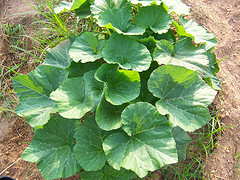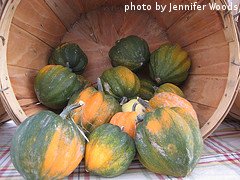How To Grow Acorn Squash
So, if you want to learn how to grow acorn squash, you've come to the right place. Many folks enjoy growing acorn squash, not only because it tastes great, but also because it is so easy to grow. Once the seeds are planted, minimal effort is required to produce several sweet, nutty, buttery, delicious squash that can then be used in a wide variety of recipes. Our favorite way to prepare acorn squash is to simply roast it with a little bit of butter, salt and cinnamon.
Acorn squash are simple to plant, care for and harvest. Bush varieties don't take up much space in the garden and can be grown in containers as well as in traditional vegetable gardens. Most acorn squash varieties are ready for harvest 75-100 days after the seeds are planted. We've been growing acorn squash for decades, and wouldn't think about planting a garden without it.
Marcus' earliest memories of acorn squash involve brown sugar and butter. His mother would send him out to the garden to pick a couple of ripe acorn squash. She would then cut them in half and remove the seeds, saving them for roasting later. She'd then sprinkle a little cinnamon and salt on each half and add a pat of butter before covering them with foil and roasting them in the oven. When they were done and dinner was ready, she'd add a small spoonful of brown sugar to each half before putting them on a plate. When they were eaten, most of the brown sugar had melted into the squash. As a young man, it felt like we were eating dessert as our vegetable. This tradition of cooking acorn squash has now been passed down to the next generation, who always looks forward to a meal that involves sweet and nutty acorn squash with a little bit of cinnamon and brown sugar.
In some parts of the country, ripe acorn squash can be almost as much of a symbol of fall as pumpkins or other squash varieties. They add a nice touch to a harvest display or an autumn scene along with pumpkins, Indian corn and of course, straw bales. In our area, our acorn squash are typically harvested in the summer, and while we eat a few in July and August, we like to save most of our squash for autumn. There's just something about eating an acorn squash soup when the weather turns cold that warms our souls.

Acorn squash plants produce fruit that typically sit very close to the base of the plant. They require 6-8 hours of direct sunlight daily. Acorn squash plants thrive in nutrient rich soil that is loose and airy. The seeds germinate best when soil temperatures exceed 60 degrees F, and the plants typically thrive in temperature of 70-90 degrees F. They will tolerate short periods of slightly warmer weather if they get enough water.
It's usually best to sow the acorn squash seeds directly into the soil where you want the plant to grow since transplants don't usually do well if their root systems are disturbed. Most acorn squash plants produce 4-6 individual squash, although we have heard of some folks getting 8 or more if the growing conditions are good and the plants remain healthy.
After harvesting, acorn squash can be stored whole for several months under the right conditions. They will also last for a long time in the freezer if you roast them off first, and store the flesh in an airtight bag or container. Acorn squash also make good fall decorations, especially if you let them ripen fully so that there's a nice orange spot on the skin. Acorn squash can be mashed, fried, steamed, roasted, boiled, baked and used to make soups and stews. You can even harvest the seeds and toast them in the oven for a rare and tasty autumn snack.
Quick Overview of How To Grow Acorn Squash
Planting: Plant seeds 1 inch deep about 2 weeks after last expected frost when soil temps have warmed to at least 60 degrees F. Space plants 2-4 feet apart, depending on type (vining or bush).
Fertilizer: Use balanced formula and apply once during planting and again when blossoms appear.
Water: Keep soil moist but not wet.
Harvest: Pick squash when skin is hard and there's a dark orange spot on the fruit.
Recipes: When you're done growing acorn squash, you can roast, fry, boil, steam or even smoke it.
Click on the following links to learn more about growing your own acorn squash.

Click here to move from our How to Grow Acorn Squash main page to our Planting Acorn Squash page
Click here for information about watering and fertilizing acorn squash plants
Click here to learn about harvesting acorn squash
Click here for some of our favorite acorn squash recipes
Click here for information about different acorn squash varieties
Click here to diagnose and cure common acorn squash plant problems